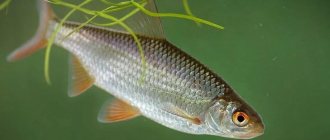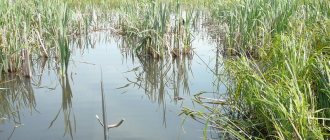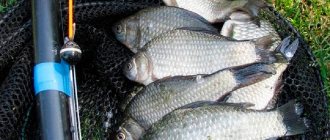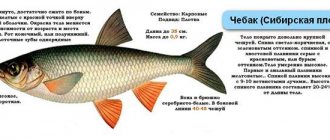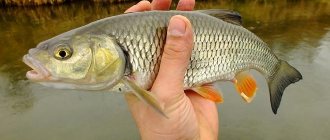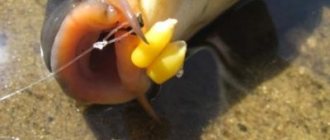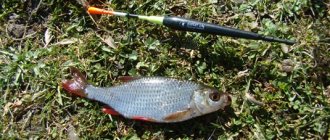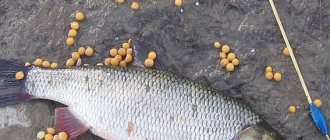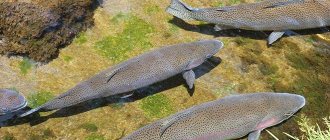Equipment
To fully install a fly rod, you need correctly selected equipment elements:
- Connector.
- Fishing line.
- Float.
- Sinker.
- Leash.
- Hook.
- Coil.
Connector
The connector is the main element of the equipment. It is used for quickly changing fishing line. The connector is attached to the end of the fishing rod.
There are three types of connectors:
- Store bought. Before purchasing a connector, you should try it on your fishing rod, since they are made to a certain diameter. Afterwards you need to glue it to the tip of the fishing rod.
- Homemade. It is necessary to attach a small carabiner to the end of the rod and tie it with fishing line, after which it is recommended to coat it with a little glue. But such homemade connectors fray the fishing line over time.
- Included with the rod. On good and high-quality fishing rods, the manufacturer independently installs a connector that can withstand good force.
Main line
It must be remembered that fly fishing is catching not very large fish, so a fishing line with a thickness of about 0.2 mm is usually used. It is recommended to use monofilament, as it is more sensitive than braid.
Choosing a float for a fly fishing rod
The choice of float directly depends on the body of water where you will be fishing. If the current speed is low or there is no current at all, then you should take a more sensitive float. If you are fishing on a river with a fast current, then you should take load-lifting spherical floats.
Victoria Leshchenko
I've been working hard in the fishing tackle department for the past six years. I can help you assemble almost any gear.
Ask a Question
The most common option is a teardrop-shaped float with a thin base and a long antenna.
Sinkers, leader and hook
For a fly rod, small sinkers are used, which are distributed throughout the tackle. This allows the bait to sink longer.
You should also ship the leash along its entire length. The correct choice of leash: length from 10 to 25 cm and diameter up to 1 mm.
The hook used is small - No. 3-5 with a long shank.
Coil
Fly rods usually do not use a reel, as it creates some inconvenience when fishing, but sometimes simple reels are still taken with them. They are used to store fishing line when the fishing rod is folded.
Advantages of a fly rod over a regular one
The main advantage of a fly fishing rod over other gear is quite obvious:
First of all, this is the possibility of high-speed fishing;
The absence of long-term manipulations to reel in the fishing line makes a fly rod the most comfortable means of fishing;
With its help, you can quickly and efficiently check the terrain, depth and strength of the current.
An undeniable advantage of a fly rod is also mobility. This quality allows you to achieve high results of fishing on the river.
The light weight of the gear makes it possible to work with it for a long time. It is also worth noting that fly rods have an affordable price. The advantages inherent in the operating principle of a fly rod make it the easiest way to fish in open waters.
Lure
You can use any bait for fishing - store-bought or homemade. The prepared complementary food should contain bait that will catch fish. When feeding, you do not need to use too much bait, as the fish will be oversaturated and will bite less actively.
You can add various flavors to complementary foods, which will increase the quantity and quality of bites. The following flavorings can be noted:
- Garlic.
- Anise.
- Hemp.
- Vanilla.
- Honey.
- Dill.
Choosing a fishing spot
In summer, fish stay at shallow depths (1-4 m) due to the fact that in hot weather there is more oxygen, food and there are no sudden temperature changes. First you need to find a free area where you can cast your rod. It is also necessary to find a flat bottom, where there is a kind of shelf on which bottom fish wander in search of food. Basically, the first edge begins right behind the aquatic vegetation; bait and bait should be thrown into this place and the cage should be successfully filled.
To accurately determine the location of such a section of the bottom, you should use a depth gauge. It is a brass or lead weight that is attached to a hook. On a fly rod, a lead weight with a ring at the end is often used. The optimal weight of the load is about 15-20 g.
When fishing in an unfamiliar body of water, you need to assemble a fishing rod and attach a depth gauge to the hook. Then walk along the coastal area in search of a suitable place. To do this, you should carefully check the bottom topography and determine the approximate depth. Once the fishing point is found, you can feed the fish and wait for a bite.
Fishing technique and tactics
When fishing with a swoop, it is necessary to keep the line in tension throughout the entire fishing process, that is, the rod is in your hands.
Advantages:
When biting, you can immediately hook. Since the fish is cautious, when it feels resistance, it spits out the bait and does not even get caught with its lip. If you put the rod down and loosen the line, you may not have enough time to hook.
When fishing with a swoop, to increase the likelihood of a bite, play with bait. When the fishing rod is in your hands, fishing becomes a more interesting and productive activity, because you need to lift it, playing along with the bait. When fishing in still water, you need to raise the line a little, then the bait with the hook will rise, and the fish will be interested in it.
Victoria Leshchenko
I've been working hard in the fishing tackle department for the past six years. I can help you assemble almost any gear.
Ask a Question
When fishing with bait, sometimes large fish are interested in fishing, which can break the gear. If there are strong bites, it is recommended to quickly change gear to stronger ones, but if you do not do this, you may miss a large fish or break the gear.
How to catch fish
Catching fish with a fly rod is not easy work. If the fish is large, it must be brought closer to the shore more carefully. It is not recommended to immediately remove the fish from the water; you must first tire it out. The main mistake that leads to breakage of the fishing rod or breakage of the tackle is the powerful lifting of the rod when landing fish. In order to eliminate this, you need to have a landing net with a long handle, this will allow you to not have to put the rod high in order to remove the fish from the water.
Swing cast
To properly cast a fly fishing rod, you must follow the following tactics:
- release the rod a little forward;
- pull him sharply by the shoulder;
- Smoothly cast to the baited area.
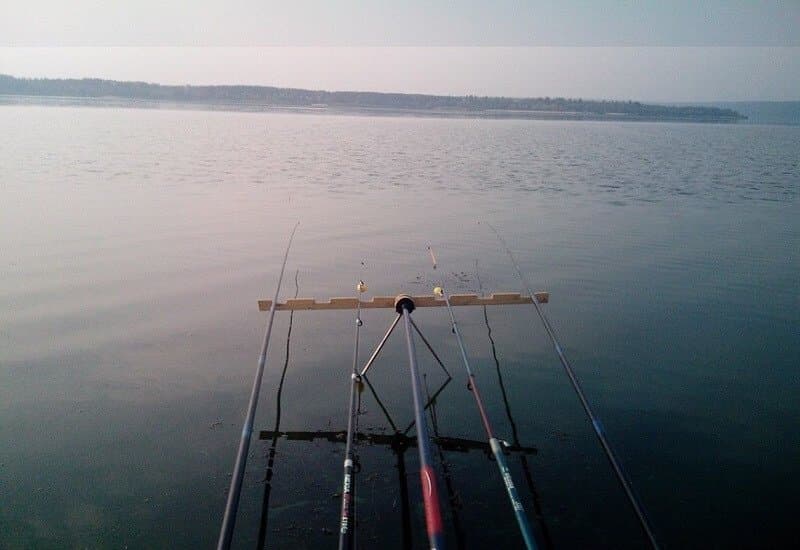
Fishing with a fly rod in the current
Fishing with a fly rod in the current is somewhat different from fishing in still water, primarily this is manifested in the specific requirements for the rod. It should be as light and rigid as possible. And if everything is clear with the weight of the fishing rod, it should be as light as possible, because you will have to hold it in your hands all day. With rigidity, everything is not so simple; there are certain criteria and frameworks.
As a rule, when fishing in the current, fairly light equipment is used, which means it will be most convenient to use medium-action rods. Soft rods behave quite poorly in windy weather and are difficult to control, while hard rods, on the contrary, are better. But when it comes to fishing, the situation is the other way around: a medium action rod better dampens the jerks of large fish and it is much easier to pull them out.
It is best if you have two pairs of rods, one short - about 5 meters, and the other long - about 8 meters: a short rod is convenient to use for fishing near the shore, and in strong currents, and a long rod is much easier to fish in deep places.
It is best to choose teardrop-shaped floats with a fairly long keel; they behave well in the current and can be cast without any problems. Note that the higher the current speed, the more your float should look like a ball. When you slow down the equipment, the spherical float will not jump out of the water. True, if the fish bites on the rise, you won’t notice it, but in a strong current this practically never happens.
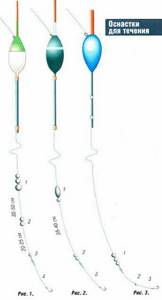
Let's take a closer look at the photo of the rigging of a fly rod for fishing in strong and medium currents. By the way, this type of gear is considered the main one. Picture 1:
- main sinker;
- additional weight;
- grazing 0.08-0.15 grams;
- leash 20-25 centimeters.
Figure 2 shows the rigging of a fly rod for fishing in very strong currents. Its main components:
- main weight;
- grazing 0.2-0.5 grams;
- leash 20-40 centimeters;
Very often, fishing with a fly rod in the current occurs using an interesting method; fishermen call it “with a wire.” Figure 3 shows the equipment for this method:
- main sinker;
- grazing 0.1-0.3 grams;
- leash 25-40 centimeters.
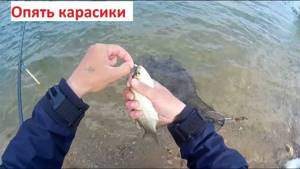
Fishing for crucian carp with a fly rod
Everyone knows that crucian carp is a small, but harmful fish. Catching crucian carp with a fly rod is quite a difficult task, but attracts many fishermen. What makes it especially attractive is its dynamism, constant experiments and greedy fish bites. The fly rod is universal and one of the most catchy tackles.
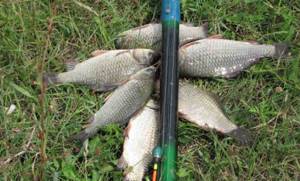
For such fishing it is necessary to choose places with a depth of 5 to 10 meters. Large crucian carp often approach the shore, and this increases the chances of catching a trophy specimen; the main thing is to choose the right place for fishing.
Catching roach on the fly
If you are going to catch roach with a fly rod, then you should not forget about its caution. To catch large fish, you should use delicate gear, use a fishing line with a minimum diameter and small hooks. Changing the length of the leash is also welcome; I recommend not making it shorter than 15 cm.

The roach takes a very long time to taste the bait, then you can observe a very sharp bite. And in order not to miss it, you need to constantly hold the fishing rod in your hands in order to hook it in time. As for the bait, this is an individual matter, I prefer corn.
Don’t forget about feeding the fishing spot; after the first feeding, you need to periodically throw a few balls of bait to the float. If the fish stops biting and bait does not change the situation, then it is recommended to change the fishing location.
Fishing for bream with a fly rod
Consider general recommendations and concepts for catching bream, since everyone knows this and there are no secrets there. I will only consider the main mistake that almost all novice fishermen make, as a result of which they then abandon the swing altogether.

This mistake is commonplace; beginners try to catch bream in half the water, although most often it takes the bait from the bottom. Even the physiological characteristics of the fish correspond to this - its mouth is directed downwards. Therefore, you need to measure the depth so that the bait lies at the very bottom. The length of the leashes for bream is about 15 – 20 centimeters. Now all that remains is to wait for the float to rise.
How to catch bleak with a fly rod
In order for fishing for bleak with a fly rod to proceed without incident, you need to choose a fishing spot with a clean bottom, free from snags and aquatic vegetation. It is best to find such a place near trees inclined towards the water. Bleak is very often there.
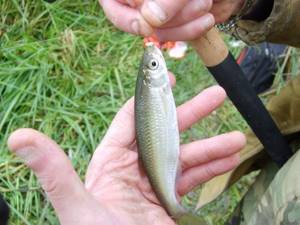
The fishing process begins with feeding the area; you need to scatter a couple of handfuls of bait within a radius of up to 0.5 meters near the float. To prevent it from sticking to your hands, just slightly moisten them. After feeding, we put the bait on the hook and start fishing.
